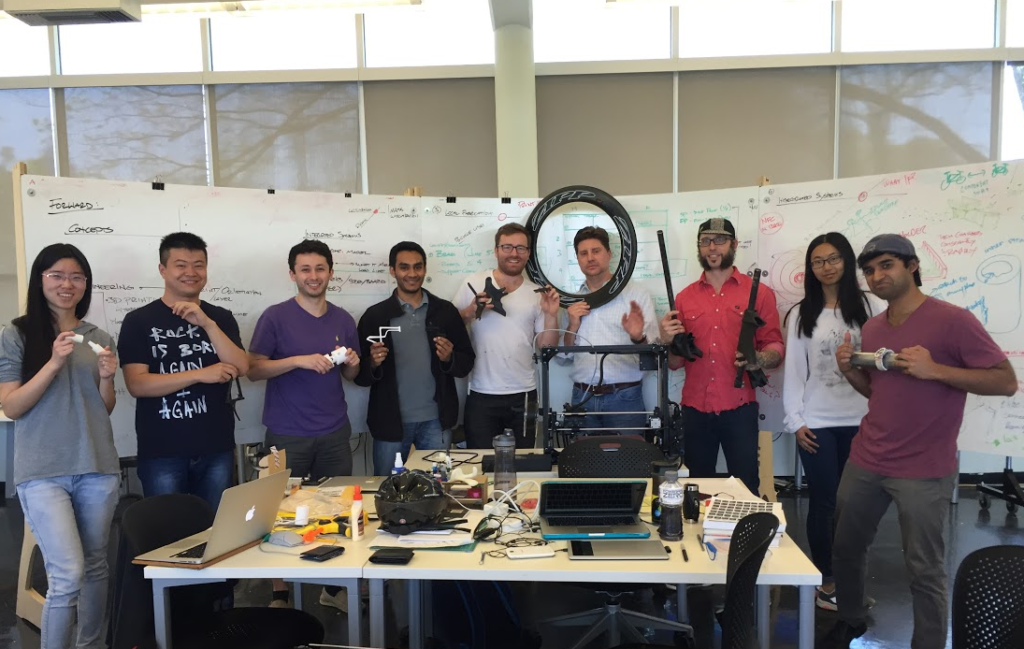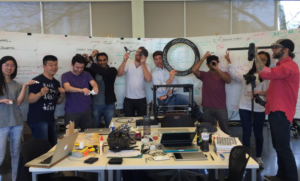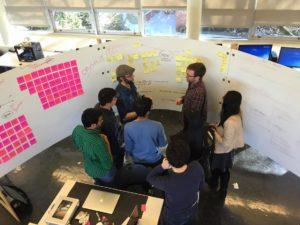“Ever tried. Ever failed. No matter. Try Again. Fail again. Fail better.” – Samuel Beckett
 As spring flowers bloom and trees bud new leaves, many are inspired to spend more time outdoors — often enjoying activities such as riding bikes. While high-tech activities like 3D printing often lead to more time indoors, the two do not always have to remain separated as 3D printed bicycles take to more streets around the world.
As spring flowers bloom and trees bud new leaves, many are inspired to spend more time outdoors — often enjoying activities such as riding bikes. While high-tech activities like 3D printing often lead to more time indoors, the two do not always have to remain separated as 3D printed bicycles take to more streets around the world.
In spring of this year, a partnership budded between Georgia Tech and Eastman Innovation Lab with the intent to not only build a 3D printed bike, but to ride it across the entire state of Georgia in a June race. While we have seen 3D printed bikes of various designs, we have not yet seen one created for use in a high mileage, cross-country race. The project offered the potential benefit of being able to 3D print new replacement parts should any in-race breaks occur, as well as the opportunity for GT industrial design graduate students to work with sponsors from EIL. The bike was to be created using a colorFabb filament made with Eastman’s Amphora, as colorFabb has shown that its materials are very workable for racing bikes. Also sponsoring the project were Ultimaker and LulzBot, both companies renowned for impressive hardware offerings in the 3D printing space.
EIL’s role as the project sponsor was to provide support, guidance, and consultation to students as needed, as the students would be the ones driving innovations here. The intent for the students was to examine two-wheeled transportation through human-powered vehicles and parametric design approaches. The entire project certainly proved to be a learning experience, as the team logged their project, starting at the beginning of April, as #idGTprojectrIDe.
 Spanning about 11 weeks, the project served to teach the students a lot about the design process, full of “AHA! moments” and discoveries about the capabilities of additive manufacturing. Ultimately, however, as often happens with big goals, the 3D printed bike was not ready to race in June — though this failure to launch certainly does not represent a failure in the project. As any innovator will certainly share, failures lead to some of the most critical discoveries and opportunities to learn; iteration, after all, is one of the key values inherent in additive manufacturing, as it often takes several attempts to create a winning version of any new design.
Spanning about 11 weeks, the project served to teach the students a lot about the design process, full of “AHA! moments” and discoveries about the capabilities of additive manufacturing. Ultimately, however, as often happens with big goals, the 3D printed bike was not ready to race in June — though this failure to launch certainly does not represent a failure in the project. As any innovator will certainly share, failures lead to some of the most critical discoveries and opportunities to learn; iteration, after all, is one of the key values inherent in additive manufacturing, as it often takes several attempts to create a winning version of any new design.
The team behind the bike learned important lessons about overcoming the challenges inherent in designing a fully rideable 3D printed bicycle of which, unsurprisingly, there were many. While the initially targeted race was a no-go for the bicycle this year, the team’s flexibility and willingess to continue the process has led them to discover new future opportunities that will still be available to them to test the design out once it is trail-ready.
To learn more about the incredible obstacles and spirit of the team behind Project rIDe, I had the opportunity recently to pose A Few Questions For Georgia Tech Assosiate Professor of Industrial Design Kevin Shankwiler, who provided insights into the successes and challenges of the project.
How did the teams from Georgia Tech and Eastman come together to begin working on a collaboration to create a 3D printed bicycle?
– This collaboration is the result of a relationship built over the years through the Industrial Designers Society of America (IDSA) and the culmination of a 5-year studio design project. The Eastman Innovation Lab is a big supporter of design education, and as a result Farrell Calabrese, Bryan Shackelford and I have become colleagues and friends through IDSA conferences, activities and campus visits.
– Secondly, for the past five years, I have run a bike design project through my junior industrial design studio, supported by SRAM Corporation, where my students employ human-centric research and design techniques to re-imagine bicycles for commuting around town.
– About a year ago this time, I was discussing the ongoing bike project with Bryan. He was very interested and replied, “I may have a material for you.” Initially in the fall, the junior studio proposed concepts around integrating 3D printing with cycling. The students delivered concepts in the form of full-size mockups and proposed novel applications around customization and advanced fabrication, programmed part replacement, and integrated systems. We then saw an opportunity to move forward on these concepts with graduate students who could do further user research, refine the junior students’ ideas and turn the high-level concepts into ride-able, testable prototypes.
– This is not the first 3D printed bike out there. There have been a number of other bikes fabricated, built and ridden around town or around parking lots as demonstrations. Ours is going be the first (to the best of our knowledge) to put in serious miles on a real-world ride.
Can you tell us about the cross-state ride this was meant for?
– Our original target for the project was the annual Bicycle Ride Across Georgia (BRAG). This is a seven-day tour across the state of Georgia, drawing one-to- two thousand cyclists each year. This would have provided our bike with significant exposure to the cycling community while providing team support. Unfortunately, we were unable to complete the bikes in time for BRAG and to ride the event safely. Instead, continued development of the bikes to a point where we can safely throw a leg over and ride them.
– Our new goal is to ride the Silver Comet Trail. This is a Rails-to-Trails type of trail that runs from Atlanta and into Alabama. This is a trail and not tied to a specific event, so we can ride when we’re ready. After that, we will bring the bike to various cycling events around the state to engage with riders firsthand.
What software was used during the design process? How long did it take? Who led this effort?
What materials were used to 3D print the bike components?– We used a variety of CAD modelers, visualization, and printing (slicer) software in the development and fabrication of the bikes. The total effort lasted three months, approximately two of which were devoted to concept development, design refinement, and fabrication design. The effort was led mostly by the Georgia Tech graduate students, with supervision and coaching from me (Kevin).
– CAD: SolidWorks, Fusion 360
– Rendering/Visualization: Keyshot, Sketchbook Pro
– CAM Slicers: Cura, Simplify 3D
– Amphora XT-CF20. Blend of Eastman’s Amphora copolyester for 3D printing and carbonfiber.
– Extruded by ColorFabb
What happened that the race could not be completed?
– What didn’t happen?! Design is a process of learning through iterative development and failure. We learn by making assumptions tangible, testing them, and learning from the outcomes. ‘Failure’ is not a bad word, rather, it is a necessary component of learning and development.
– Technical issues with printing coupled with abrasive nature of the material. We learned that 3D printing is not a flawless process. We encountered issues and failures with parts not designed well for the printing process, fast deterioration of print nozzles due to the abrasive nature of the material that led to part failures, and some failures within the equipment and part programming itself.
– All that coupled with the iterative nature of the design process meant our bike development took longer than originally scheduled.
– From the start, this was a very ambitious project. I believe strongly in setting ambitious goal for students and projects. If it’s not challenging, then it’s not worth doing. While we missed our original target, the project continues to move forward.
What were some of the challenges that arose in the design process?
– From a design perspective, we encountered challenges including:
– Limits in part build size related to using desktop consumer printers.
– Engineering of designs/parts to exploit the structural characteristics of the XT-CF20 material. If you consider a traditional bicycle frame as a triple-triangle layout (one triangle at the front connecting the seat, pedal crank-arms and headset, and two others either side of the rear wheel) and you add the weight of a rider sitting on the bike and pedaling (load), then some members are in tension while others are in compression. Designing parts and understanding their orientation on the print bed to exploit these forces became critical.
– The last area of challenge centered on customizability of the designs. Important questions such as these became important to thoroughly address:
- What parts/areas of the bike would be customizable?
- How would they be customizable?
- What would NOT be customizable?
What did the team learn from these challenges?
– A LOT was learned from working through these challenges.
– We learned how to design parts in segments to fit on a printer, or how to split larger pieces into smaller components (think “LEGO”).
– Proper print orientation on the printer bed is critical to account for compression and tension loads.
– To design “zones” of customizability, dictating what areas are customizable for users and what areas would be “fixed.” The greater the degree of customization is possible, the more complicated the model becomes.
Will a similar effort be made anytime soon?
– Yes. We are now targeting a ride in early September. (see earlier comments re: Silver comet Trail)
– The project continues. Over the Fall semester, a second bike concept (the “Spine”) will be completed, assembled and ridden.
– Inherent in the customizable nature of these bikes, they will continue to evolve with input from potential riders, from performance data gathered on rides and from unforeseen (but expected) failures. They will serve as research platforms exploring user-centric design methods for cycling innovation.
How do you see 3D printing and other 3D technologies coming more into use in everyday life?
– The advantages and opportunities for 3D printing lie in the ability to fabricate custom and one-off parts, complex parts that previously required multiple parts and processes, and in democratized or distributed manufacturing, where parts an products cand be fabricated on site, rather than in a facility far away from the consumer.
– Currenly there are a number of every day manufactured goods employing 3D printing behind the scenes. Consumers don’t necessarily see these technologies, but they are in use in products we use every day.
– As we see 3D printing technologies evolve and mature, this will affect more of the goods we consume. We will see more products customized to individual users, more products produced in a greater variety of materials, greater performance of 3D printed materials, and more local fabrication of parts and products.
– 3D printing for the masses, however, is still a way off. Right now, most consumers engaged in 3D printing are either hobbyists, home fabricators (part of the new ‘maker’ movement) or DIY-ers. We hope that through project like our 3D printed bike, we can push the 3D printing momentum forward and enable new and more applicable methods of manufacturing for people.
Projects such as this, especially those featuring partnerships between innovative organizations sponsoring student study at universities, certainly offer incredible inspiration in the high-tech arena. Particularly impressive here is the spirit of true education, in which failures are simply another means to discovery — and serve as motivation and foundation for future projects.
Subscribe to Our Email Newsletter
Stay up-to-date on all the latest news from the 3D printing industry and receive information and offers from third party vendors.
You May Also Like
Profiling a Construction 3D Printing Pioneer: US Army Corps of Engineers’ Megan Kreiger
The world of construction 3D printing is still so new that the true experts can probably be counted on two hands. Among them is Megan Kreiger, Portfolio Manager of Additive...
US Army Corps of Engineers Taps Lincoln Electric & Eaton for Largest 3D Printed US Civil Works Part
The Soo Locks sit on the US-Canadian border, enabling maritime travel between Lake Superior and Lake Huron, from which ships can reach the rest of the Great Lakes. Crafts carrying...
Construction 3D Printing CEO Reflects on Being Female in Construction
Natalie Wadley, CEO of ChangeMaker3D, could hear the words of her daughter sitting next to her resounding in her head. “Mum, MUM, you’ve won!” Wadley had just won the prestigious...
1Print to Commercialize 3D Printed Coastal Resilience Solutions
1Print, a company that specializes in deploying additive construction (AC) for infrastructure projects, has entered an agreement with the University of Miami (UM) to accelerate commercialization of the SEAHIVE shoreline...




































